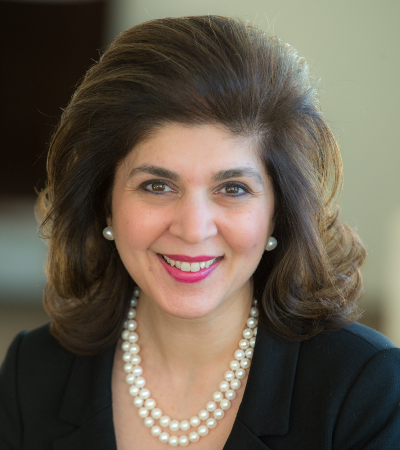Women and Children to the Front
Across ideologies, women and children are playing more prominent roles in terrorist groups.

Published by The Lawfare Institute
in Cooperation With

Editor’s Note: In recent years, men have had the dubious distinction of dominating the ranks of terrorists, but that may be changing. Farah Pandith and Jacob Ware of the Council on Foreign Relations argue that women and children, who are typically portrayed as victims, are playing important roles in terrorist movements today and that counterterrorism needs to adapt accordingly.
Daniel Byman
***
“Our fellow men were being arrested …. We decided to put women in the front line.” That’s how Munir Kartono, a former Indonesian Islamic State leader, described to a journalist for CNA Insider the efforts he pioneered to recruit women as suicide bombers. The advantages were twofold. First, he said, “women tend to connect easily with one another,” making recruitment, radicalization, and inspiration to martyrdom easier. But female recruits also provided strategic value. Police were “more respectful to women, especially to the ones who wore a hijab or covered their body.” This made hiding a suicide bomb easier.
Women in extremism are often portrayed as victims—of their husbands, of their societies, or of the radical ideologies that inspire them. Often, the extremists themselves appeal to this narrative as they seek leniency and mercy for their actions. Shamima Begum, a notorious Islamic State female fighter who traveled to join the group in Syria at age 15, has for instance made frequent claims of self-defense, asserting that she was “groomed” into joining the Islamic State in 2015. Her claim is an attempt to rob herself of agency and affix blame for her decision to join a murderous terrorist organization to someone else. In so doing, she has, purposely or inadvertently, appealed to an age-old counterterrorism fallacy—that “women and children” are always victims, never assailants.
But over the past several years, a number of cases, across multiple ideologies, suggest that women and children are now playing a greater role on the extremism stage—from the Islamic State to QAnon.
For starters, the Salafi-jihadist extremist movement has been boosted in recent years by the active presence of women. Although women and children made up only 25 percent of foreign Islamic State members at its height, the dying embers of the Islamic State’s caliphate in Syria have to no small extent been stoked by women, particularly in Syria’s sprawling refugee camps. In al-Hol, for instance, Islamic State women killed over 70 people last year. Even Begum, who lives in al-Roj camp, claims to fear the group’s hardline female fighters. “For a long time it wasn’t violent but for some reason it’s become more scary to live here. Maybe the women have got tired of waiting for something,” she told the Telegraph in November 2021. Boko Haram, meanwhile, has made frequent use of female suicide bombers, and by 2018, more females had been arrested for links to the group than males.
Despite its setbacks, the Islamic State retains a potent ability to radicalize youth through open and accessible social media platforms, including in the West. Earlier this year, for example, three teens, one as young as 15 years old, were arrested for an Islamic State-inspired plot to attack a Chicago-area Shiite mosque. And in 2020, Belgian police caught two minors, aged 16 and 17, plotting an attack on police. Minors’ attraction to extremist jihadist ideology is driven in no small part by the online medium, where the distance between recruiter and recruit has never been smaller. A recent groundbreaking study by the Institute for Strategic Dialogue (with which one of the authors is affiliated) found that “Salafi content is becoming increasingly popular on Gen-Z-focused platforms such as TikTok, where influencers with followings in the millions make full use of the platforms’ features to amplify and promote polarising sectarian narratives.” A recent public announcement given by the leader of al-Qaeda in the Arabian Peninsula nodded to the importance of “youths and girls” to global “jihad.” As with policies toward women, this increasing emphasis on recruiting children is a deliberate strategic choice made by extremist groups.
Governments tracking these new terrorism foot soldiers are raising the alarm. A National Counterterrorism Center bulletin from 2018 warned that “[v]iolent extremists’ use or encouragement of minors to conduct attacks probably stems in part from their desire to influence impressionable supporters and circumvent [counterterrorism] security measures that monitor for suspicious activities conducted by adults.” Meanwhile, the Syrian Democratic Forces (SDF) is keeping 700 boys in prison, warning that these “cubs of the caliphate” are too dangerous to release, and that they may have been trained to conduct suicide bombings.
The far right, too, has benefitted from broader recruitment. Women have always played leading roles in the movement as organizers and supporters, but they had an important role in the violence of the Jan. 6 attack on the U.S. Capitol. So far, 14 percent of the more than 800 arrests connected to the attack have been of women. A mother-daughter team helped organize the “Stop the Steal” rally, a QAnon-supporting woman was killed by police when she attempted to enter into the Speaker’s Lobby, and a transgender woman served as an alleged “ringleader” of a group of Oath Keepers who now face seditious conspiracy charges. Another woman arrested for her part in the Jan. 6 attack had bragged about her participation during a livestream, saying, “We were looking for Nancy to shoot her in the friggin’ brain but we didn’t find her.” Given that Jan. 6 saw women directly participating in violence at the core of the mob, the day “represented a break from the norm” in which women are traditionally placed in more supporting roles, Hilary Matfess and Devorah Margolin argue. Traditional female roles, in which women are in the background supporting the men (in the domestic setting, for example), have been upended. Women extremists are out in public—active online and participating in direct action.
QAnon has been a particularly interesting case study. The movement has spread through yoga and mindfulness communities, a trend emblematic of QAnon’s broader efforts to appeal to traditional femininity. Its “save the children” rallying cry, for example, appeals to maternal instincts among would-be recruits. “QAnon might have initially emerged from masculine spaces,” Mia Bloom and Sophia Moskalenko write in a recently published book about QAnon, “but the movement only took off once it found fertile ground in feminine online spaces like women’s Facebook groups and Instagram.” Many of the violent plots conducted by QAnon adherents have been perpetrated by women. One woman, a would-be assassin, was arrested in May 2020 after traveling to New York to “take out” then-candidate Joe Biden, and another was arrested three months later for ramming her car into a crowd of people who she believed were involved in the kidnapping of children. In September 2022, a woman was arrested for making a bomb threat against the Boston Children’s Hospital’s transgender care unit.
But among the far-right, children have been even more prevalent. In perhaps the most notable case, a 13-year-old Estonian boy made international news in 2020 when he was caught by police leading an international terrorist organization. Reporting by the Guardian has detailed multiple other arrests of teenagers on terrorism charges—including several 14-year-olds. Counterterrorism police in Britain are now warning parents about the concerning rise in far-right radicalization among children. According to Sky News, “In the year ending 30 June 2021, children under the age of 18 made up 13% of all terrorism arrests.” This was the highest percentage since records began. The British nongovernmental organization (NGO) Hope Not Hate revealed in 2020 the existence of a mostly youth-based far-right group called British Hand, which was led by a 15-year-old and recruiting children as young as 13. And young people are also often pursued by the U.S. group Patriot Front, who appeal to youth with propaganda that promotes an image of a “young warrior.” Again, young people playing a role in terrorism is not new—online extremism, for instance, was first flagged as an emerging concern in 1984, in an Anti-Defamation League report that warned that online hate networks were “[seeking] to spread their hate propaganda among young people, surely the most vulnerable to its influence.” But this latest development, in which children recruit other children, is novel, and it speaks to the concerning new agency that young people have online.
Are there reasons why these less-traditional demographics have not played a more active role in terrorist violence itself, despite a clearly higher-profile role across the extremism and radicalization landscape? With children, it could be a capability issue—simply put, a 13-year-old might not have the skill or strength to really do that much damage. With women, we may just be lucky to not have witnessed more bloodshed. Take the example of two far-left female activists who were arrested after placing shunts on train tracks in Washington state throughout 2020. It is remarkable that more damage was not done.
If the trend continues, and women and children appear not only with more frequency in arrests but also as successful perpetrators of large-scale attacks, societies will have to redesign counterterrorism and countering violent extremism (CVE) efforts for a new chapter. Building a strategy to reflect these changes would be prudent. Policymakers, researchers, and counterterrorism and CVE practitioners must reevaluate current programs to stop the appeal of extremist ideologies for both men and women; this would result in a forward-leaning posture, one that addresses future dangers as well as current threats across ideologies and demographic groups. This should include comprehensive scaling of on- and offline prevention programs that address not just ideology but also the yearning for belonging, identity, and adventure that terrorist recruiters exploit. Efforts should also include new support for NGOs doing local work, continued pressure on technology companies to act on recommendations to limit extremist content online, and campaigns to build societal awareness of the extremist landscape.
More simply, we, as societies, must check our biases about the threat posed by women and children and recognize them as people with responsibility for their actions. Leniency in prosecutions fails to recognize their agency. And yet women continue to receive special treatment, as occurred recently, when a German former Islamic State female fighter was allowed to walk free, despite being found guilty of membership in a terrorist organization, because she had promised to “reintegrate into society.” This was merely the latest data point in a long-standing trend of women receiving shorter sentences than men for similar extremist crimes.
Counterterrorism officials often fail to act on emerging trends until it’s too late. With the “women and children” cliché now being turned on its head, policymakers must act quickly, before this latest development emerges as a major national security concern.






